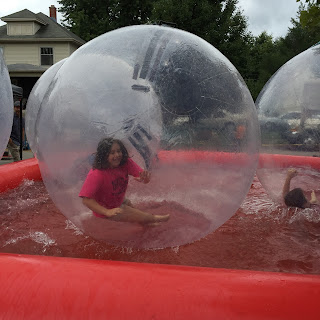I grew up about half an hour from Berne, Indiana, and I didn't hear about the Swiss Heritage Museum and Village until I read about it in preparation for our year of exploring locally. We've been to many historical homes and historic areas including Conner Prairie, the Huddleston House and the Levi Coffin House in Indiana, Williamsburg (VA), the Hermitage (TN) and many others. So, I expected the Swiss Heritage Village to just reiterate what we already knew about our colonial history. I was pleasantly surprised!

When we arrived at the Swiss Heritage Museum, we were greeted by a costumed guide who led us on a tour of the property. A fascinating 84 year old volunteer (who has been there since 1999), our guide was able to expand on the story of the artifacts and structures we encountered with stories from her own life using these tools. Our tour group included our family (me, the kids, and 2 grandparents) along with a couple visiting from western New York. He, too, grew up using many of these now outdated items. What a great discussion!
 |
| Cheese Press |
The history of Adams County, Indiana, is different from the area closer to us. Mostly settled by Swiss immigrants who came to the area seeking to escape from religious persecution, they brought distinct cultural and religious traditions. Many of these immigrants were Mennonite or Amish, and today Berne is home to some of the most traditional Amish in the country. This unique history is similar and yet very different from other immigrant groups. This area was settled in the 19th Century, when several families moved to the area and recruited the first cheese maker away from his community in Ohio. The cheese shack was the first I've seen! It was interesting to see the cream separator and the cheese-making tools.
 |
| Cream Separator |
 |
| A Mennonite Church |
We were able to see a log cabin (1839), a farm house (1856), an historic barn (1900), an early Mennonite Church (1860), a doctor's office, and several other buildings. Every building is furnished with beautiful furniture and other artifacts original to the area and the period.
The school (built in the 1860s) was fascinating, showing the pledge written on the board (as it was written then), the flag showcasing all 45 states at the time, and a small library of period books. We saw the tools for washing throughout the years (from a washboard to very early washing machines), early strollers, toys and handcrafted cabinets.
 |
| Cider Press Building |
Another highlight on the tour was the world's largest cider press, a fascinating, hand designed and hand built cider press. We definitely plan to come back the 2nd week of September next year when the Cider press is operating. I can't wait to taste the cider!
 |
| Working the Cider Press |
In addition to the Village itself (a 60 minute tour, so worth a tour without all the extras!), the property includes a 6-acre nature center with a forest, a pond and wetlands. There are many native trees and plants to view during your peaceful stroll through the woods. The Museum is also worth a visit with beautiful handcrafted furniture, historic mail trucks, washing tools, and other artifacts that tell the local story.
 |
| Hay Bale Equipment |
 |
| An old Stove |
 |
| The Doctor's Office |
I loved loved visiting the Swiss Heritage Village and Museum, and my kids loved comparing this history to the history at Conner Prairie. For example, the gardens at Conner Prairie (1836 Hamilton County) have weeds in them whereas this garden was immaculate. Our tour guide once asked the expert locals why they had to keep their gardens weed free. They said, "no, the Swiss would never have allowed weeds in the garden!" The families in Prairietown did not feel that way. Different culture, different ideas. We definitely plan to go back for one of their special events next year so that we can see the village in action. Well worth a visit!
Details:
1200 Swiss Way
Berne, IN 46711
www.swissheritage.org
260-589-8007
Open Hours - May, Saturdays only 10-4, June-October, Monday-Saturday 10-4
Special Events: Berne Swiss Days last Friday and Saturday of July, Heritage Festival, 2nd Saturday of September






















































